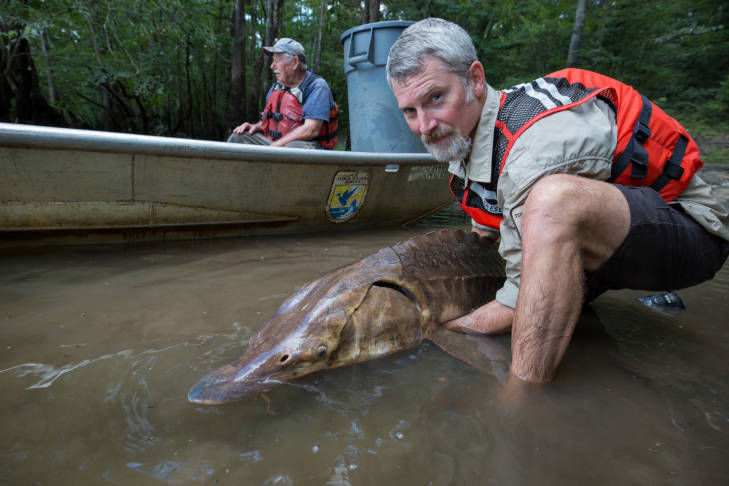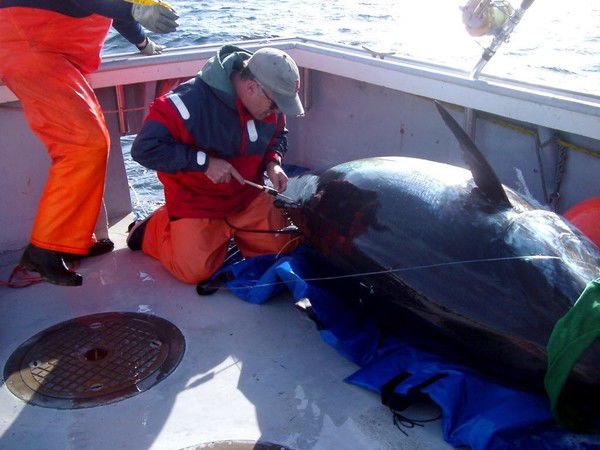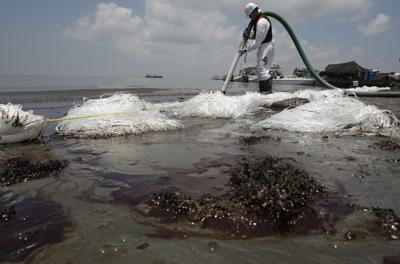It's been 10 years since the Deepwater Horizon oil rig exploded, killing 11 people and spewing about 134 million gallons of oil into the Gulf of Mexico over three months.
Its most visible impacts -- oil mats, birds covered in crude and dolphins washing up on shore -- are long gone, and the gulf is teeming with finfish, shellfish and large marine mammals. But the signs of normalcy belie a more complicated truth: Researchers say the Gulf still hasn't fully recovered, and it could still be years before the full extent of the damage is known.
Much of what we do know about how Gulf species and the environment were impacted comes from research funded by a $500 million pot of money -- called the Gulf of Mexico Research Initiative -- put up by BP immediately after the spill and distributed over 10 years. That money will run out in June. Here's what some of the studies have found:
Every fish tested in the Gulf of Mexico has some trace of oil in it. Dolphins living in Barataria Bay have high rates of chronic lung disease and lower birth rates. And the coastal wetlands nearest the spill site may never fully recover.
In general, the impacts were more acute near the wellhead. Deepwater fish populations within 200 miles of the site have dropped by between 50% to 80%. And it's gotten quieter: The sounds of whales hunting for fish near the site has decreased.

With a oil derrick looming in the background, pelicans nest and hatch young on the islands of Cat Bay, on April 19, 2012. The area was heavily oiled during the BP oil spill.
Over the past few years, Steven Murawski, with the University of South Florida College of Marine Science, and his team have sampled fish from the continental shelf around the entire Gulf of Mexico. "We didn't find any animals that didn't have at least some trace of oil pollution," he said.
Fish surveyed near the wellhead had the highest levels of hydrocarbons, and the levels of oil in all fish declined between 2010 and 2016, he said. Together, these data indicate that, while there are other sources of oil pollution in the Gulf, the Deepwater Horizon was likely the culprit.
While researchers found oil in the fishes' bile and livers, it wasn't at levels that would make them harmful for humans to eat, Murawski said. "It's not a matter of human health. It's a matter of fish health," he said.
As the 10th anniversary of the BP Deepwater Horizon oil spill approaches, state and federal agencies should consider nine strategies aimed at …
Some of the most visible health symptoms exhibited in fish have faded with time. For example, skin lesions observed on fish early on later disappeared. Yet, the potential impacts on fish populations may be further prolonged by the fact that fish can transfer toxic amounts of crude oil into their eggs.
"Maternal offloading has been demonstrated, and is potentially a big hazard for the developing eggs and larvae since these life stages are much more vulnerable than adults," Murawski said.
Fish could also become recontaminated from two large remaining reservoirs of oil from the BP spill, he said. One is on the bottom of the deep ocean and the other is in the marsh system in Louisiana. By some estimates, 4% to 10% of the oil spilled remains in the environment, mostly in those two sites.

U.S. Fish & Wildlife Service aquatic ecologist Adam Kaeser, releases a Gulf sturgeon at the Panama City (Fla.) Fish and Wildlife Conservation Office on Aug. 18, 2018. A $2.15 million research project aimed at identifying ways to restore the fish's habitat is one of three projects proposed for funding under the BP oil spill Natural Resource Damage Assessment program. (Photo by Ryan Hagerty, U.S. Fish & Wildlife Service)
Researchers continued to see oil seep out of fiddler crab burrows when they walked in the marsh in 2018, said Louisiana State University marine scientist Nancy Rabalais. While this oil has not been quantified, scientists have found that it hasn't fully degraded. Indicators of oil toxicity in water have dropped over time, but they still haven't fallen to where they were before the Gulf oil spill.
Oil is not only harmful to wildlife that lives in the marsh, it can kill the wetlands themselves. As oil blankets the marsh surface, it blocks oxygen from reaching the roots of plants. The roots then begin to decompose and let go of the soil they were holding onto "and then the whole marsh falls apart," Rabalais said.
While Louisiana has high rates of coastal erosion, oil washed into the wetlands from the Deepwater Horizon oil spill exacerbated the land loss. "Unless there's a marsh creation project in the area, that's lost habitat," she said.
Exhibit A: Cat Island. Once a brown pelican nesting ground full of black mangrove bushes, all that remains is a thin strip of crushed shells. Sea-level rise has continued to drown coastal bird habitat in the Gulf in the years after the spill, said Erik Johnson, director of bird conservation for Audubon Louisiana. This makes it difficult to isolate the spill's impact on birds.

Dr. Steve Wilson, a Stanford University marine research scientist, installs a satellite radio tag on a 700-pound Atlantic bluefin tuna in October 2008. The fish entered the Gulf of Mexico on March 23, 2009, to spawn, and returned to the Atlantic on May 24, 2009, a journey that took it near the Deepwater Horizon rig site and through much of the area where oil from the rig has been mapped. (Photo courtesy of the Stanford Tuna Research and Conservation Center.)
Early estimates put the number of birds killed by the Gulf oil spill at nearly 1 million. Researchers have since said they can only be certain that perhaps 100,000 birds were killed, but without good pre-spill estimates, the exact number of birds killed can't be determined, Johnson said.
The bird losses in the northern Gulf, the area of the spill, were massive. One study estimated the spill wiped out 36% of the laughing gulls, 15% of royal terns and 12% of brown pelicans.
While bird populations have remained fairly steady since the spill, Gulf birds aren't in the clear yet, Johnson said. Just like in humans, diseases like cancer take longer to manifest in birds. That's what happened with the Kittlitz's murrelet, a small seabird, after the 1989 Exxon Valdez oil spill in Alaska. The species saw a significant decline from chronic conditions nearly 15 years after the spill.
"So, it's important to stay vigilant and monitor these populations," he said.
Chronic diseases have already shown up in many bottlenose dolphins in the Gulf. Lori Schwacke, chief scientist of conservation medicine for the National Marine Mammal Foundation, said that Barataria Bay dolphins were 5 times more likely to have lung disease than dolphins in Sarasota Bay, Florida, that were not impacted by the spill.
While President Donald Trump's administration was working to relax offshore drilling regulations, there was a spike in offshore accidents and …
While 65% of pregnant dolphins surveyed in unoiled areas produced viable calves, only 20% of pregnant dolphins in Barataria Bay had healthy babies. “We feel like that's probably related to the health of the moms,” Schwacke said. “We don't expect the reproductive success to improve until the overall health of the animals improves.”
The Barataria Bay population will likely only recover when a new, healthy generation becomes mature. But a lower rate of successful births and a slower life cycle means that’s still years away. Dolphins mature at 8 or 9 years old and they tend to reproduce only every three years.
Early estimates suggested it would be 39 years before bottlenose dolphin populations recovered completely. “From what we're seeing I think that's going to hold true,” Schwacke said.
While there is no way to undo all of the damage caused by the Gulf spill, a portion of the legal settlements paid by BP and its drilling partners was set aside to help animals impacted by the spill. This money could be used to address other stressors to dolphins, including accidental entanglements in fishing gear and other marine debris.
But addressing the health problems for whales may be harder. That’s in part because many people don’t even know that there are whales in the Gulf of Mexico, said Natalia Sidorovskaia, a physics professor at the University of Louisiana at Lafayette.
“People know about dolphins,” she said. “When I tell them there are 800 sperm whales in the Gulf of Mexico, people get very surprised.”
While studies by Schwacke and others on dolphins indicate that whales likely experienced health problems, but they are too big to catch and examine. That’s why Sidorovskaia has spent nearly 20 years using acoustic sensors to listen to whales in the Gulf, dating back before the oil spill.
Sperm whales and beaked whales can hold their breath for an hour while diving under the water surface for food. More than half a mile below the surface, the Gulf is devoid of light and the whales must use echolocation to spot their prey.
But this sound was rarely observed near the site of the wellhead after the Gulf spill, Sidorovskaia said. “The sensors close to the site had much less activity of sperm whales than areas further away to the west,” she said. “Which was very different than 2007 data, where we had a lot of activity on the site.”
That’s likely because near the wellhead, deepwater fish and invertebrates, like squid, died, leaving the whales little to eat. Since 2015, sperm whales and beaked whales have started to move back into the area. But there’s still a lot of analysis yet to be done, Sidorovskaia said.
Queen Bess is one of Louisiana's largest rookeries for brown pelicans.
“They are there now. We hear them,” she said. “Did they get impacted? Yes. How much? We don't know yet.”
Sidorovskaia is hopeful that the amount of research to come out of the Gulf oil spill will help to inform decisions about conservation in the future. Last year, the Gulf of Mexico Bryde's whales were listed as federally endangered, following an uptick in acoustic research after the Gulf spill.
“I never saw so much research money put in the Gulf of Mexico,” she said.
Before the spill, there was very little baseline data on the Gulf environment, Murawski said. “It's been an underinvested area for a long, long time,” he said. “The BP money has been a real shot in the arm for science in the Gulf of Mexico.”
The money hasn’t just gone to studies. BP also agreed to spend $8.8 billion to repair or restore the various environmental injuries identified in damage assessments. Of that, about $1.6 billion will be spent to replenish the stocks of a raft of Gulf animals, ranging from sea turtles to marine mammals to coral and oysters. A much bigger slice of the settlement, almost half, will seek to address the damage the spill caused to wetlands and coastal and nearshore habitats.
While the damage from Deepwater Horizon may never be completely repaired, the money from the various settlements has allowed Louisiana to make real progress on efforts to rebuild its coastline, which was washing away long before the 2010 spill.
Nearly a decade of BP-funded research has uncovered a laundry list of potential health effects resulting from the Deepwater Horizon oil spill,…
For instance, a large share of BP settlement money will fund one of the nation’s most ambitious coastal restoration efforts using dredged material. The state Coastal Protection and Restoration Authority plans to use more than 75 million cubic yards of sediment from the Mississippi and Gulf of Mexico to rebuild about 11,000 acres of coastal land.
Fifteen dredging projects will go out to bid this year, said Rudy Simoneaux, CPRA’s engineering chief.
“We’re talking historic times for our dredging projects ... not just for Louisiana but the nation,” he said.
-Staff writers Tristan Baurick and Mark Schleifstein contributed to this report.













